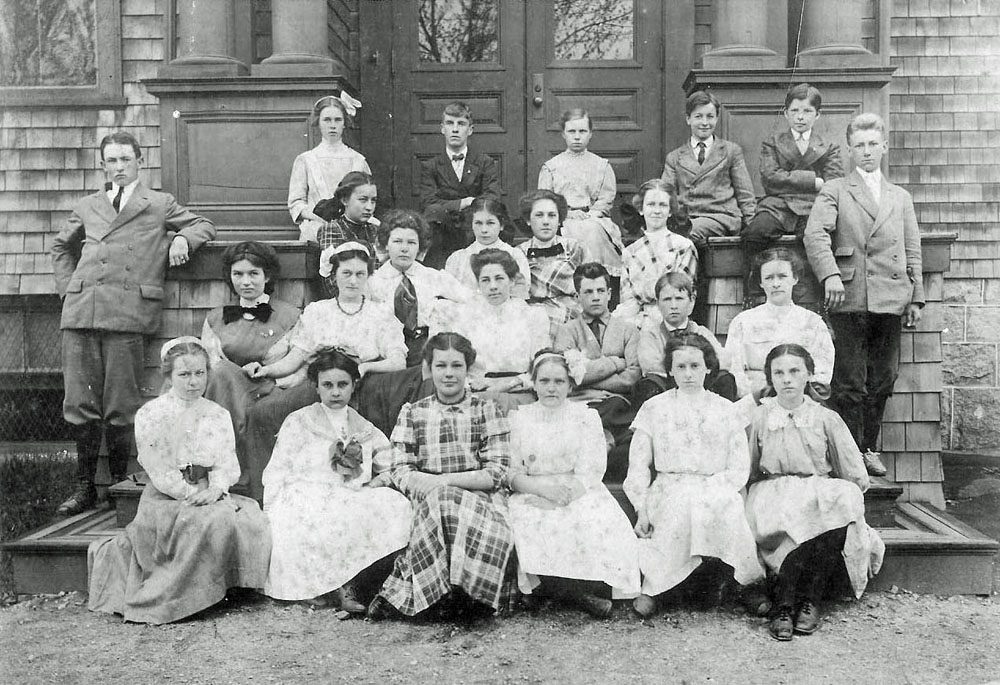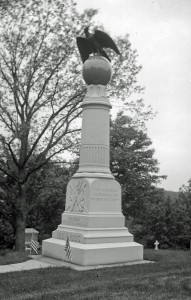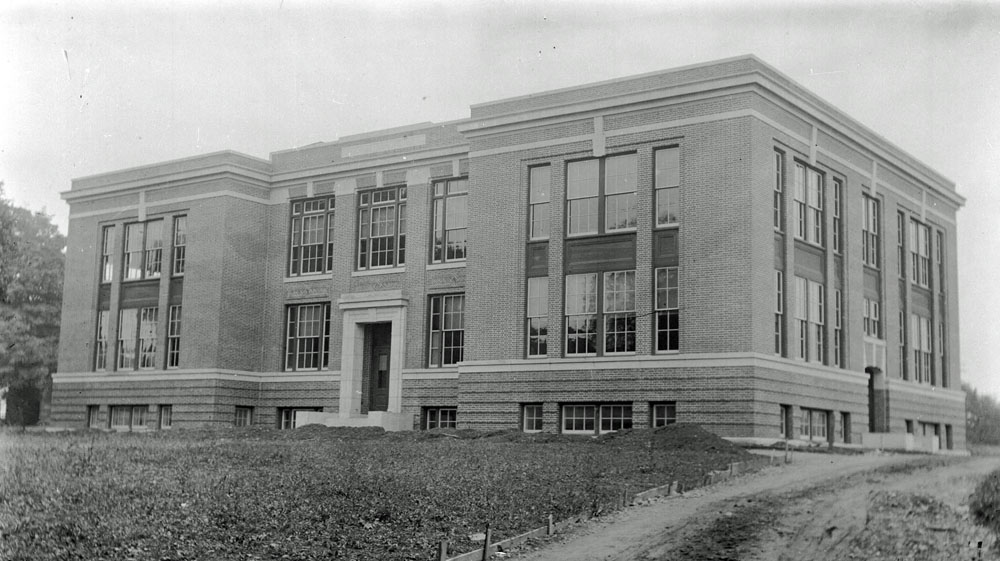True Tales: 100 Years of Staying the Same
By George T. Comeau
The Crane Grammar School’s graduating class of 1911. This would be part of the entering class at the newly built Canton High School in downtown Canton. (Courtesy of the Canton Historical Society)
We trace the arc of the seasons across the years, and the old adage quickly points out that the more things change, the more they remain the same. Looking back at Canton exactly 100 years ago, the year 1911, the observer is struck with the normalcy of life and the fact that things really don’t change all that much.
There are the births, deaths and marriages, neighbors supporting each other over the fence and across the backyard. A year near the turn of the last century also had its share of accidents that beset a small New England industrial community. The emerging auto age and the declining horse and cart were in constant opposition with each other. Issues such as roads, schools, taxes, youth needs, and support for veterans were at the forefront of the concerns facing Canton in 1911. Constructing new downtown buildings, industries moving to town, and the housing needed for an emerging middle class all made headlines.
Turning to our soldiers, as we have been celebrating the sesquicentennial of the Civil War, so too, the residents of Canton were finding ways to celebrate the 50th anniversary of conflict between the states. Larra Wentworth, a lifelong resident, veteran, and pillar of the community worked tirelessly to promote the erection of a monument that would become a memorial to the soldiers and sailors that participated in the Grand Army of the Republic. Throughout 1911, money was raised for the monument fund that would build the memorial and place it at the Canton Corner Cemetery. Celebrations were held to mark the 50th anniversary of the departure of Company A, 4th Regiment from Canton. Children raised money by selling candy and having charity concerts.
Wentworth’s work parallels the work of our veterans’ agent, Tony Andreotti, who tirelessly supports and finds ways to mark the work of our veterans. J.N. White & Sons built the civil war memorial monument in West Quincy. Constructed out of the finest quality Westerly, RI, and Quincy blue granite at a cost of $1,700, the monument would be installed in October 1912 at a large public ceremony. You can still see this testament to the Civil War as you pass the gates of the Canton Corner Cemetery. The bronze eagle that was originally on top was stolen a number of years ago by thieves seeking scrap metal. The eagle was never recovered.

The Grand Army of the Republic monument. (Photo by Charles E. Cole, courtesy of the Canton Historical Society)
As for politics, 1911 saw the presentation of a plan by Abner Morse that “advocated an elected board of five selectmen to serve without pay, with authority to employ an executive clerk at a salary of one thousand to twelve hundred dollars per year.” The thought behind the plan was to minimize the day-to-day demands upon the Board of Selectmen and get “public spirited citizens of ability to serve the town.”
It became Article 19 at the annual town meeting and it was met with enormous controversy. This proposal was soundly defeated by a vote of 107-57, and it would take more than 90 years to effect the proposal. Today, of course, we have a five-member board and a strong town administrator, but history shows that this idea took quite some time to gain general acceptance. Some folks in Canton still question the need for a five-member board, but it seems to be working quite fine, and perhaps Abner Morse was just ahead of his time.
The Annual Town Meeting Warrant of 1911 had 30 articles for consideration, and the entire municipal budget stood at $96,498. Most notably, spending was requested to support the new high school. In 1910, the town began construction on a new building that would bring all high school students into one space dedicated for their education.
Town meeting voters were asked to pay for furnishings for the new high school, which had just been completed along Washington Street, now the present-day Hemenway senior housing complex. The building shell itself had cost Canton $47,000, and another $11,600 was spent on furnishings for the new schoolhouse. The school was opened for public viewing on Saturday, September 9, and hundreds marveled at the “modern” facility. Built to house 200 students, the new school featured a chemical laboratory, a drawing room, recitation rooms, locker rooms and “twelve new typing machines.” The high school replaced an ancient wooden building on Washington Street, which had long outgrown its usefulness.
And as it is today, the focus on our children and their education was of paramount concern. A committee was engaged in studying the facilities of the schools in Canton and found many to be in dreadful conditions of overcrowding and of poor ventilation and overall design. The town was yet to have a playground dedicated to the youth of Canton.
And Alec Marsden, a 1911 graduate of the Crane Grammar School, implored the leaders of Canton to find “a place where boys can shout without being told to ‘make less noise,’ where they can have a good game of ball without being told to ‘get out,’ for a place where boys can lie on the grass without watching for a policeman. Such a place would keep children off the street where they are constantly getting into mischief.” Marsden went on to point out that other towns had been furnishing playgrounds for children and that “Canton should wake up to the fact that a playground is a real need.” These are some of the same arguments that are shared today when local citizens encourage calls for a community youth center.
A child 100 years ago could get in all sorts of trouble if left to his own devices. Esther and Henry McMorrow, brother and sister, were charged with trespassing upon the property of Jeremiah Kelliher in Ponkapoag. The children were caught picking berries and hauled into District Court, where they were placed on probation for two months. Example set.

The new high school on Washington Street was completed and open in 1911. (Courtesy of the Canton Historical Society)
Also, 1911 was the year that the town began a process of numbering the houses along our streets as both a finding aid and a way for the assessors to create a system for taxing these homes. The house numbering system also meant that Canton could receive City Free Delivery of mail twice daily through the U.S. Postal Service. Three carriers would cover all of Canton and the hiring requirements stated that they must be “male applicants, at least 5 feet 4 inches tall and weigh at least 125 pounds in ordinary clothing.” On December 1, the first mail carriers began delivering to Canton homes and businesses.
One of Canton’s oldest and most famous buildings was lost forever to wrecking crews in July 1911. The Paul Revere House on the site of the Plymouth Rubber Company had sustained damage from a fire earlier in the year, and by mid-summer the demolition was required to ensure safety and expansion of the plant. The house was built in the early 1700s and was purchased by Paul Revere as his home on the site of the first rolling mill in the United States. Originally a house built for the town miller and ultimately the most historic home in Canton, this was a very sad artifact to lose.
The loss of the Revere House was balanced by the fact that the Canton Historical Society completed construction of their building along Washington Street in December. The history of the people, places and things that were important to the leaders of the early society are preserved today and continue the legacy found within this 100-year-old building.
For those folks who complain today about the excesses of signage around modern Canton — the unsightly billboards or banners that adorn our streetscapes — the sensibilities of 1911 were no different. A citizen wrote to the local newspaper, “The pictures which we have to look at in the streetcars of people washing their heads, bathing their feet, and in all states of distress” call for “reform needed in this direction.” The citizen argued that “a tired and careworn public should have more enlivening and pleasant things to look at.”
Not all signs were considered blight. The Edison Illuminating Company made a deal with the Canton Improvement Association to erect a double-sided, 50-foot-long sign placed in full view of all trains traveling through Canton Junction and advertising Canton as a great destination for business and living. 1911 was shaping up to be a boom year for new factories, new housing, and expanded facilities for public use.
The Canton Improvement Association was charged with ensuring that the economic development of the community was enriched by improvements in infrastructure. Much like our present-day Economic Development Committee, they were responsible for presenting the “opportunity of Canton” to attract growth and prosperity.
Looking back helps us know that we are connected to the same concerns and community needs that have always made Canton the town that it is. One hundred years from now I expect that the issues of traffic, water, development and industry will be framed in a new context. The history of our town is continually evolving, but what stands constant as we change the calendar is how wonderful it is to live in a town rich in history and tradition.
Short URL: https://www.thecantoncitizen.com/?p=10488










